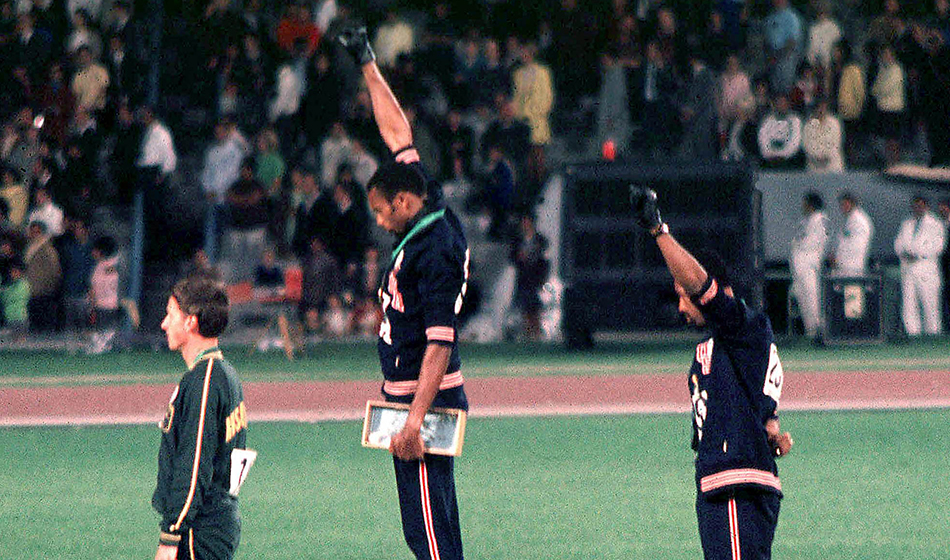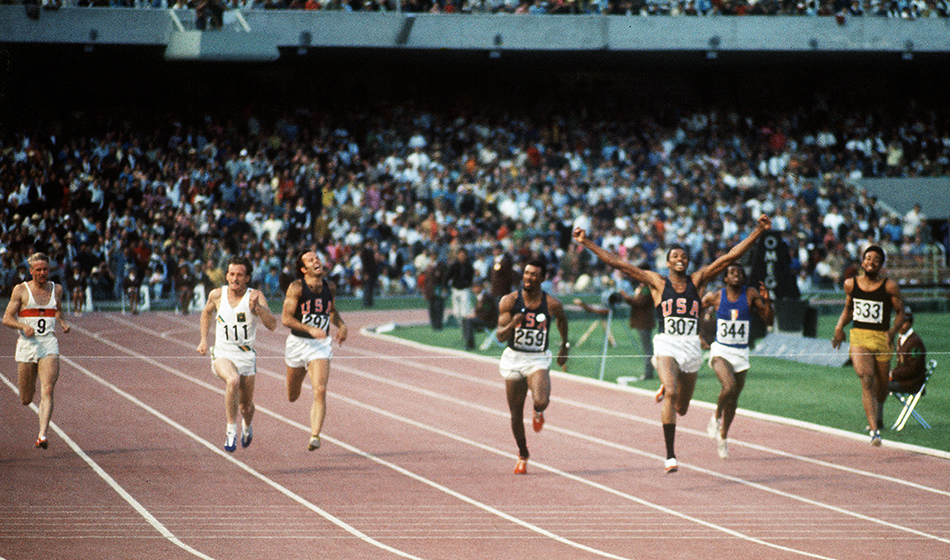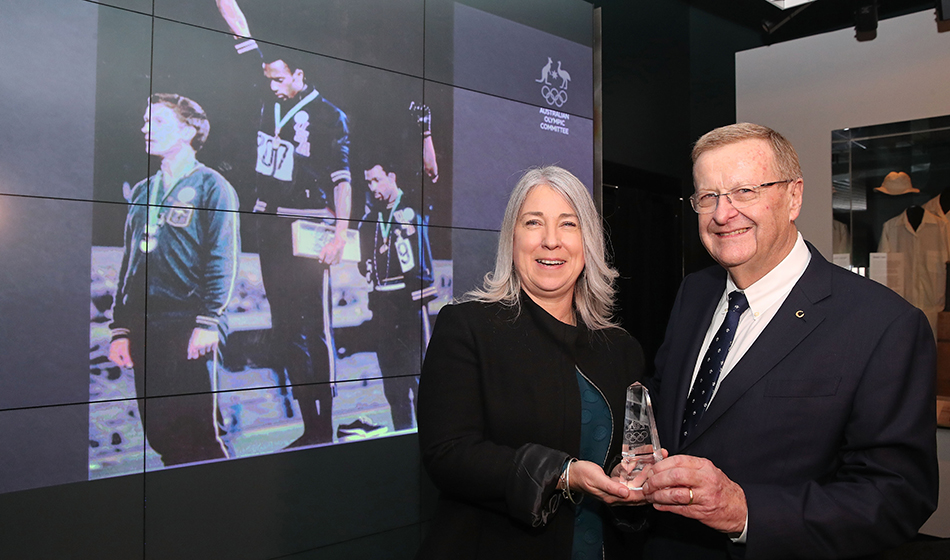Whereas Tommie Smith and John Carlos have turn into recognized all through the world for his or her black energy salute on the 1968 Olympics, the athlete who stood with them in help on the rostrum has been much less celebrated. In his new e-book, Doug Levy examines that story
When the second in time got here to determine what was proper, Peter Norman selected human rights. Peter Norman? To educated sports activities followers, it’s a title that may ring the faintest of bells – if it rings one in any respect. Comprehensible on one hand, but unhappy on the opposite.
It has been over a half century since he first gained acclaim as a man who might run very, very quick. His story unfolded on October 16, 1968 on the Olympic Video games in Mexico Metropolis. The celebrity he obtained for his 200m silver medal is just not the distressing a part of his journey. As a substitute, it’s the unhappy lack of understanding of his position after the race concluded.
Many individuals recall, or have heard about, Tommie Smith and John Carlos on the 200m podium, their dark-gloved palms raised skyward in salute to Black energy and human rights. Typically forgotten or neglected are Peter’s concepts and actions, depicting him as a civil rights trailblazer who stood with them.
“In a method, his story is extra vital than Tommie and John’s,” stated Matt Norman, Peter’s nephew.

Peter’s story can be a posh one. There’s little in dispute about what he did on that October day and why it mattered. The stuff of disagreement lies in what occurred to him afterwards, the therapy he obtained, and the way lengthy it took for him to be duly recognised. Sadly, the talk has endured with out Peter’s personal voice; he died of a coronary heart assault in 2006. It has since been left to others to dissect the small print and to find out, in their very own minds, whether or not or how a lot Peter suffered for his actions at that Mexico Metropolis medal ceremony.
Within the race itself, Smith gained in a world file of 19.83. Peter, brandishing his fearsome ending kick, took silver in 20.06. Carlos settled for bronze in 20.10.
However to foreshadow the significance of what Peter then did on the stroll as much as, and on, the rostrum, it’s useful to dial again to what had preceded these Video games. African American leaders had threatened a boycott; in spite of everything, racial tensions had boiled within the months since Martin Luther King Jr. had been assassinated in Memphis. Whereas the boycott was known as off, civil rights chief Harry Edwards did orchestrate a sequence of protests to raise the reason for racial equality on the Olympics.
The plan was for Smith and Carlos to be two of the important thing baton-carriers for spotlighting the necessity for racial justice in entrance of an Olympic-size crowd. Peter pumped extra gasoline into the hassle. A couple of minutes after his legs took him 200m in simply over 20 seconds, he made rapid-fire selections together with his conscience and his thoughts. Taken collectively, they screamed “human rights ambassador” a lot louder than “quickest white man on this planet.”
It was Peter who had discovered of the gesture Smith and Carlos had on the prepared and who had stated: “I’ll stand with you.” It was Peter who, upon studying that Smith had solely two black gloves for his or her post-race demonstration quite than the 4 that they had deliberate on, instructed every of the 2 males put on and lift a single glove. They agreed. And it was Peter who, seeing a member of the US crew staff stroll by sporting an “Olympic Undertaking for Human Rights” button, requested if he might put on it on the rostrum.
If it doesn’t look like Peter’s actions that day had the potential to be world-altering, properly, let’s put a magnifying glass again on the social and civil unrest across the globe again then.
In 1968, Black People have been only a few years faraway from having been advised they might not eat on the identical eating places, drink from the identical water fountains, or sit in the identical part of a public bus as white individuals.
Apartheid raged in South Africa. Aboriginal individuals in Australia suffered a lot the identical racial indignation and had not been recognised as Australian residents with full voting rights till 1962.
The stakes have been completely different for Peter than they have been for Smith and Carlos. The 2 African American sprinters had a trigger to highlight, they usually have been all in. Peter had a perception that the trigger was simply, and he joined the demonstration in his personal method. However he should have instinctively recognized he wouldn’t be celebrated for it.
As Matt stated: “The world was coping with huge racial points – the assassinations of [Robert F.] Kennedy and MLK [Jr.], the therapy of aboriginals – for Peter to face up as he did was exceptional to me.”
It was not the standard set of actions for a Caucasian athlete, or any white man of the late Nineteen Sixties, to take. “That’s what makes it so unbelievable – it simply wasn’t accomplished,” stated his daughter, Janita. “He needed to be extremely brave, and he did act out of his beliefs.”

Whereas Peter’s post-race actions triggered some damaging blowback, they didn’t stain his standing with Athletics Australia officers – a minimum of not within the quick aftermath. Nevertheless, issues obtained messy for him.
One bone of main rivalry concerned the 1972 Olympic Trials for Australian sprinters and the selection of who to take to the Summer time Video games in Munich. Athletics Australia had a qualifying customary of 20.9 for the 200m. Peter had crushed that loads of instances, however within the nation’s Olympic Trials in Perth – competing on an injured knee – he took third place in 21.6.
Did a 30-year-old Peter merely fail to summon up a adequate efficiency on the very time he wanted to? Or had his post-race Mexico Metropolis actions in some way gotten in his method?
Strath Gordon, the chief of public affairs for the Australian Olympic Committee (AOC), stated Peter’s failure to qualify was not a mirrored image on his actions in Mexico Metropolis. “He was injured and on the finish of his profession. He ran a poor time.”
In that very same vein, a post-Olympic Trials article from The Age, a every day newspaper in Melbourne, quoted Peter as saying: “I’m historical past. I’m out of the staff.” The reporter, Ron Carter, additionally wrote that Peter “most likely ran himself out of the staff”.
However there are extra particulars to look at. In that very same article in The Age, Carter famous that Peter had been nursing the aforementioned knee damage for weeks. “If the selectors do the fitting factor, Norman ought to nonetheless be on the aircraft to Munich. He has run 20.5 this season and is an efficient competitor. In Munich, he would do properly.”
Then there was the confusion over what, if any, course of existed on paper to information Athletics Australia in its decision-making. Within the e-book The Peter Norman Story, the authors quoted a nationwide staff selector, Paul Jenes, as saying: “There have been no set standards. You principally picked the most effective staff.”
If that was the case, Matt stated, wouldn’t it have made huge sense to put Peter – Australia’s nationwide record-holder, the 1968 silver medalist, and the world’s fifth-ranked 200m runner – on the staff?
What made the entire saga even odder and murkier is the curious incontrovertible fact that the nation wound up not taking any male sprinters to the 1972 Olympic Video games. We don’t know what Peter would have accomplished had he been within the area for Munich, however we do know that just one 200m sprinter in 1972, gold-medal winner Valeriy Borzov, ran a time sooner than the one Peter recorded in Mexico Metropolis 4 years earlier.
Extra controversy crept up in 2000, when Australia hosted the summer time Olympics in Sydney, and questions arose as as to whether Peter was accorded the respect he deserved.
The way in which Gordon advised it and the best way Worldwide Olympic Committee vice chairman after which AOC president John Coates described it in The Peter Norman Story, Peter certainly obtained his simply due. He ran a leg of Australia’s Olympic torch relay, served as an Australian Olympic Workforce ambassador at promotional occasions, and helped christen the Olympic medals that may be used for the 2000 Video games throughout a gala on the Sydney Opera Home.

However there have been competing views, with Matt and others believing Peter was slighted. Matt conveyed in our interview that whereas Peter did play a job within the lead-up to the 2000 Video games, Australian officers didn’t invite him to any capabilities in the course of the Video games themselves. It gave the impression to be america, not Australia, that took further steps to worth Peter’s presence and to finance his attendance at occasions in the course of the Sydney Video games.
For instance, a distinguished USA Observe and Discipline (USATF) official, Steve Simmons, organized airfare for Peter to journey from his residence in Melbourne to Sydney, the place he was warmly embraced and applauded as a visitor of the US Olympic Committee (USOC).
The USOC then flew Peter to a subsequent Olympic monitor and area trials. Years later, retrospective articles on Peter indicated he had been “shunned” in 2000 and never invited to occasions. Whether or not he was wrongly snubbed by not being chosen for the Munich Video games or neglected and underappreciated in the course of the 2000 Olympics – and whether or not any of that was an after impact of his 1968 stand – will nearly certainly stay an unsettled debate.
In 2006, simply months after he had undergone a triple bypass surgical procedure, he died of a coronary heart assault. He was solely 64. If Australia had been slightly sluggish in recognising the constructive impression of what he did, maybe Peter’s funeral turned the tide.
In 2006, USATF organized to mark October 9 – the day of the funeral – as “Peter Norman Day”. USATF official Steve Simmons indicated to reporters that it was unprecedented for the organisation to declare a day in honour of an athlete outdoors of america.
After Peter’s demise, Australian officers established further tributes for him. A transformative one got here on October 11, 2012, by means of the efforts of Andrew Leigh, a member of Australia’s Parliament, who believed an official mea culpa was so as. Leigh’s movement of apology to Peter handed unanimously.
In 2018, the AOC awarded Peter with a posthumous Order of Advantage, and on October 9, 2019, Athletics Australia and the Victorian authorities unveiled a statue in Peter’s honour in Melbourne’s metropolis centre. Athletics Australia additionally established a Peter Norman Day to recognise his achievements.
Gordon admitted that reward and recognition for what Peter did in 1968 “ought to have come a lot earlier”. He added that: “Australia, just like the US, has wanted to come back to phrases with our previous and our historical past… Peter clearly stated he believed in human rights. He took a stand.”
This edited extract comes from Hero Redefined: Profiles of Olympic Athletes Below the Radar, which is accessible now at authordouglevy.com


